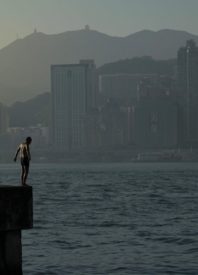
Hong Kong means many things to both Chinese people and to separatists who call themselves Hong Kong-ers. The ‘autonomous’ region is a place where Chinese people can run to, an ally to Chinese people fighting from within who want freedom. It’s a city losing its freedom. at the edge of the South China Sea’s emerald waters, the waters’ boats approaching the city’s skyscrapers. It’s also a city where white colonizers suppressed labour unions because of the latter’s suspicious resemblance to the PROC’s values. Later, it’s a city losing its freedom. Chan Tze Woon’s Blue Island expresses most of that recent history in its running time, sometimes within the same scene.
Hong Kong is, for now, a city of activists. Part of Blue Island‘s audacious conceit involves the current generation of pro-democratic activists. These protesters reenact scenes in China and Kong Kong’s recent history. During those moments, past individuals left China or protested against governments oppressing those characters. There’s an earnestness to these young people embodying their past versions that work. And what also works are scenes when these young people encounter the survivors of those generations. Still, there are scenes where all we see are the older protesters. They, for example, hug each other before being part of the dwindling June 4 Tiananmen remembrance protests. The camera captures real emotion here.
This film how isolating it is to be these Davids to a Goliath. On the flipside, the young protesters run against the stereotype that other generations have against the young. That they – or we – are politically ignorant or apathetic. Scenes with reenactments of the labour protesters of 1967 highlight this, as the young reenactors look at the work involved in a bulletin that came out 55 years ago. They acknowledge how audacious the words in the bulletin are. And seconds later, Blue Island shows the reenactments, as these actors make their own versions of the bulletins with their own hands. It’s amazing to see the protesters then having the resolve as their contemporary counterparts. But as one of them say, police intimidation is a good sign of being right.
Chan reenactments show him directing the protesters to empathize with their characters, which is easy enough for someone playing a man who swam to Hong King. It’s difficult but possible for someone in the 2019 generation to play a Hong Kong-er in 1967 who wanted to be Chinese. But then he approaches more recent history, as one of the later scenes reenact the sentencing of one of the men involved in the Umbrella movement in 2014. There, the man who plays one of the major protesters recite an inspiring speech and breaks down as he does. It’s as if no one prompted him to do so but his own experiences flashing back to him. Empathy is the whole oint of the exercise, but the film embodies those generations of protesters in a transcendent way.
Blue Island comes to OVID today.

